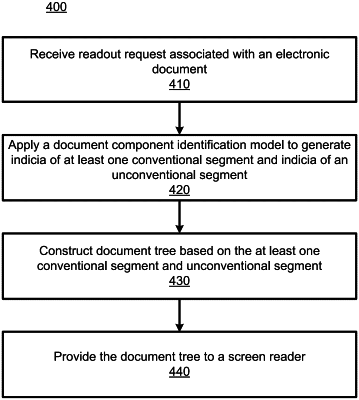| CPC G06V 30/414 (2022.01) [G06F 40/14 (2020.01); G06F 40/186 (2020.01); G06N 20/00 (2019.01); G06V 30/416 (2022.01)] | 17 Claims |

|
1. A method comprising:
receiving, from a client device, by an electronic document system, a readout request associated with reading out content of an electronic document by a screen reader application of a client device;
responsive to receiving the readout request, applying, by the electronic document system, a document component identification model to the electronic document, wherein applying the document component identification model comprises generating both an indicia of a conventional segment for conventional readout using left-to-right, top-to-bottom readout and an indicia of an unconventional segment to be read out in a manner different from the conventional readout, wherein the document component identification model comprises a machine learning model that has been trained, wherein training the machine learning model comprises:
accessing training data, the training data including labeled segments, each label indicating a segment type of a respective labeled segment;
initializing the machine learning model with an initial set of parameters;
applying the machine learning model to the training data to generate a set of predictions of a segment type for the labeled segments; and
updating the initial set of parameters based on the set of predictions and the labels associated with the labeled segments;
constructing, by the electronic document system, a document tree based on the conventional segment and the unconventional segment, the document tree representing a readout sequence; and
providing, by the electronic document system, the document tree to the screen reader application of the client device, wherein the screen reader application, when executed by the client device, is configured to perform a readout based on the document tree.
|